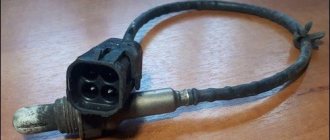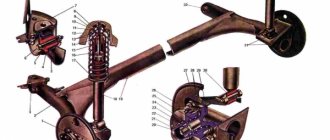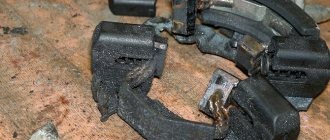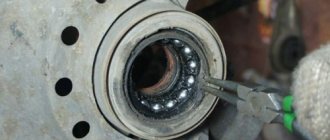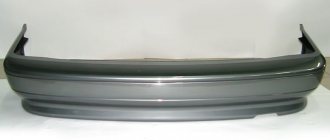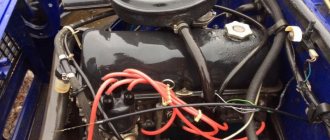After buying the car, I decided to get rid of the catalyst, since it tends to get clogged and replacing it is not cheap. Previously, on cars they stood where the resonator is and such a catalyst costs 3,000 thousand rubles. And now they have started to install them on the exhaust manifold (spider, pants, in general, whoever likes it more) and such a catalyst costs almost 10,000 thousand. Well, why do you need one like that, I thought and bought myself a replacement insert - a 4-1 spider from Stinger. The spider itself
I thought for a long time whether to change it at the service center or change it myself, because there is nothing complicated, and the service center will take a lot of money, so I decided to do this during the holidays. I arrived at the dacha, made myself a mini overpass to make it easier to get under the car, and then started disassembling it.
I dismantled almost half the car to get to this catalyst, removed the intake manifold, unscrewed all the hoses, screwed all the intake and exhaust manifolds with 13 nuts, so there are at least 30 of them screwed in there. When I got to the catalyst, I was thinking, will I put it all back together and won’t I have anything left over, as always? In general, an hour later I got to him and took off
Here it is in comparison with the new spider
Putting the whole thing back together, the work took about three hours. According to the first sensations, the car began to accelerate faster and the consumption was on average per 100 km. became 6.5-7 liters, but did not notice any significant changes. But what does the catalyst itself consist of?
Even after installation, the wire that comes from the lambda probe was a little short and I decided to fix this problem and make an extension cord, for this I bought two connectors (male/female) and twisted them together
Oh yes, after installing the spider, the check on the tidy lights up very rarely, almost never lights up and the on-board computer writes an error that the neutralizer is weak. I’m thinking about doing chip tuning, but somehow I have doubts, the consumption will increase at the same time, who will say anything about this, is it worth it or not?
Replacing the catalyst on a VAZ 2115 with your own hands
Catalyst for VAZ 2115
Every owner of a “tag” is once faced with a catalyst problem. And then he needs an urgent replacement of the catalyst on the VAZ 2115.
An old muffler often even sags so low that it clings to everything that lies incorrectly on the road surface. Of course, you can use fixing straps or wire, but this will not help.
In any case, the VAZ 2115 catalyst needs to be replaced.
Breakdowns and their signs
Typically, this element begins to “strange” when it travels about 150 thousand kilometers. That is, this is more likely an age-related problem with the car.
Standard and Modified
The catalyst consists of honeycombs that break down over time and do not block the release of harmful exhaust gases. The pressure in the exhaust system increases, exhaust gases go back into the engine, which leads to a significant deterioration in its performance. The engine is literally choking.
Typical signs that the catalyst is clogged are:
- The car's dynamics deteriorate significantly and noticeably;
- The engine starts with problems;
- There is a characteristic smell of sulfur in the cabin;
- The engine is unstable at idle.
If the car stops driving normally, it is advisable to immediately check the condition of this device. Alas, this cannot always be done in a garage environment, since special equipment and devices are required. But there are still two ways.
- Replace the lambda probe with a pressure gauge. Start the engine and check the pressure. If it is more than 0.5 atmospheres, things are bad.
- In the second case, you will need a remote pyrometer. If the catalyst is working normally, the temperature of the pipe before it will be higher than after it. But at the same temperature, this indicates the destruction of the honeycomb and a violation of the flame extinguishing function.
The second method allows you to obtain indirect data, so the pressure must be checked in any case. If a breakdown is detected, the catalyst must be replaced.
Article on the topic: Choosing high-quality material for door trim on a VAZ 2114
Replacing the device has its own characteristics depending on which engine is installed on your VAZ 2114 - eight-valve or sixteen-valve.
WHY DO YOU NEED A CATALYST?
Usually, when it comes to a catalyst, most motorists only think of a muffler, or rather a can or pipe. In fact, the exhaust system of a car includes several elements: connecting pipes, muffler, resonator, corrugation, catalyst, etc. So:
- The catalytic converter, as the catalyst is called, is a fairly important element of the car and the entire exhaust system.
- One of the main functions assigned to it is the purification of exhaust gases that flow through the pipe. The latest Euro 2 standards require the presence of a catalyst in the exhaust system of the car and a special oxygen sensor.
- The neutralizer itself, despite the fact that it is made of metal and a massive body, is a rather fragile element. He is afraid of severe mechanical damage, and is also quite sensitive to low-quality fuel. Impurities and various dirt residues contained in low-quality gasoline remain on the walls of the catalyst, gradually accumulate there and lead to damage to the part. In Russian conditions, the catalyst fails very quickly. And if, usually, it is designed for 200,000 km of run, then if it comes into daily contact with Russian fuel, it will not withstand even 30,000 km of run.
It is useful to know what a catalytic converter is made of. And find out how this part works. As was said, it reduces the amount of harmful substances and impurities that any car with an internal combustion engine emits into the surrounding atmosphere. These are substances dangerous to human health, such as carbon monoxide, nitrogen oxide, etc.
For example, carbon monoxide is a real gas that has neither color nor odor. But it is precisely this that contributes to the appearance of cardiac colic and headaches in people.
As for the design of the catalyst, it consists of a ceramic or often metal honeycomb part. Why honeycombs?
Yes, because the design resembles a honeycomb. On top of these same honeycombs, special precious metals, most often platinum, are sprayed.
Although palladium catalysts are often used in the automotive industry of developed countries.
Palladium catalyst
Replacement for an 8-valve engine
If you have a VAZ 2114 with an 8-valve engine, you need to look for this element in front of the middle resonator and after the exhaust manifold directly under the bottom of the car. Many, alas, ignore the need to replace it, believing that their car will not stop polluting the atmosphere and the engine will be able to continue to operate normally. The opinion is wrong, as you understand.
Device option for eight-valve
Some believe that instead of a failed filter device, you can install a regular corrugated pipe. Also a wrong decision. This will make the noise incredibly loud, and the exhaust gases will very quickly destroy the muffler. You can get by with a budget replacement option - cut out a section of the catalyst, knock out a honeycomb of ceramics from it and perform welding, thereby sealing the body. But be prepared for noise to become your constant companion.
It is best to replace the factory catalyst with an effective flame arrester. They assemble it with their own hands or seek help at a service station, and also purchase ready-made solutions at auto parts stores. Whichever option suits you best, choose that one.
Removing the unit and replacing it with another device is a matter of one hour. At the same time, there is no need to worry about electronics. There is only one oxygen sensor, and it is installed before the catalyst. Therefore, replacing it with a flame arrester will not affect the measurement readings in any way.
Russian catalyst massacre. What's inside after 183,000 km?
According to statistics, owners of foreign cars encounter a faulty catalyst much more often than VAZ drivers. Haven't encountered a catalytic converter failure yet? Sooner or later it will happen anyway.
However, the difference is that replacing a faulty element in a VAZ is cheaper, and the repair itself takes a little time. “Foreign cars” immediately grab their heads when the catalyst breaks down. Often, purchasing imported spare parts costs 40-50 thousand rubles.
We cut the catalyst from the VAZ-2115
Not long ago, the author of the article discovered an old catalyst in his garage. It was removed from a VAZ-2115, which had driven a little over 180,000 km. It was not possible to find a practical use for the part, so the decision was made to cut it into pieces and see what was inside. Curiosity took over. In the end, car owners often suffer from faulty catalysts - it was interesting to study the “ins and outs” of the details.
No sooner said than done. Just 2-3 minutes of working with the grinder - and here it is, the result of the cut. We invite you to look at the photo, which clearly demonstrates the “insides” of the neutralizer.
The process of sawing with a grinder
Clean as glass?
What we saw shocked us! As a rule, catalyst failure is due to two reasons:
- The elements have melted. This problem is relevant for ceramic catalysts, but in our case it is metal.
- Due to poor quality exhaust, the honeycombs were clogged. It’s strange, but even after 180,000 km, the cells are almost clean.
To be more sure, we raised the catalyst and tried to look at it in the sun. Past again - it shines through. This indicates that the item is in excellent condition.
Source: pikabu.ru
Unfortunately, such a case is rather an exception to the rule. Owners of many foreign cars (especially Korean ones) complain about the catalyst crumbling after only 20,000 km. Such cases are not isolated.
How many kilometers has your catalyst traveled? Write about it in the comments - it’s always interesting to hear the opinions of other car enthusiasts. Thumbs up if you liked the article. And subscribe to our channel to keep abreast of all the latest news and events from the world of cars.
Removing the catalyst. Pros and cons, consumption, firmware - we reveal all the secrets
Often my blog (and my channel) receives a lot of questions regarding the catalyst, and some readers still have many misconceptions in their heads. One of them (for example) is that if you remove this part of the muffler, then it will be VERY bad for the car, it will literally stand up and refuse to go! I decided to answer all the questions at once, so today we will talk: - is it worth removing it or not (what are the pros and cons of such manipulation), what will be the consumption after cutting it out, is it necessary to flash the ECU (and what are the risks), and well a few words about “deception”. In general, it will be interesting, as usual, the video version at the end...
At the very beginning, I would like to say that this unit is NOT SOMETHING IMPORTANT for the car, but now “a bunch of stones” will fly at me, they say, what are you saying, but what about ECOLOGY? But if we put aside all the exclamations of the “greens”, then a car without a catalyst will work BETTER, CONSUMPTION will be lower, and the POWER will increase a little.
How to determine if the catalyst is clogged and what to replace it with
The catalyst is an integral part of the exhaust system.
It is designed to ensure that the remaining harmful substances in the exhaust gases burn out and are released into the atmosphere in the form of water and carbon dioxide.
In general, car owners do not care whether the exhaust gases from their car are harmful or not. If you suddenly become interested in the topic of the catalyst, you are most likely interested in a spacer, spider, replacement, or you have an error. Therefore, we will not go into theory, let’s move on to your requests.
Neutralizer
The catalyst lasts up to approximately 100,000 km, then it becomes clogged, crumbles, oxidizes, and chokes the engine. But in reality, mileage is limited by the quality of gasoline, the presence of additives, and the fuel mixture. Therefore, you can destroy the neutralizer with a couple of “free” gas stations, or by destroying one of the sensors, for example the mass air flow sensor, thereby changing the mixture.
How to make a replacement
The entire replacement of the VAZ 2114 spider takes place in several stages:
- Place the car on an overpass or pit, put the handbrake on and secure the wheels with stops (shoes).
- If the car has been running recently, let it cool down.
- Remove the crankcase protection.
- Unscrew the bolts securing the exhaust manifold pants to the catalyst inlet (to make unscrewing easier, they should be treated with WD-40 lubricant before starting work).
- If the replacement is partial, then leave the catalyst and muffler in place; if it is complete, then remove it.
- Unscrew the nuts securing the manifold to the cylinder head.
- Dismantle the “original” manifold and the gasket located under it.
- Install the spider instead of the standard manifold (if the spider matches the model, then it will definitely fit into its place). Before installation, you should place a new gasket under it.
- If the old fasteners are severely corroded, then new ones should be installed instead, preferably coated with copper or brass.
- If a partial replacement is performed, then you need to check the alignment of the spider pipe with the catalyst inlet. As a rule, the exhaust pipe of the spider is longer, so you will have to cut off and dismantle not only the catalyst, but also part of the exhaust pipe, instead of which a resonator should be welded.
- Connect the spider's output pipe to the resonator.
- If a complete replacement occurs, then the same operations are performed as in the previous paragraphs, but instead of the entire “original” exhaust system, a direct-flow exhaust system is installed.
After installing the spider, you will also have to replace the lambda probe (with a new one, with an extended wire). The completion of the entire modernization process will be the flashing of the ECU, which should be performed at a car service center. It will help register the new system in the computer as “standard”, and will also show the increase in power obtained as a result of the upgrade.
Error (check) lights up after installing the catalyst
This happens when you remove the catalyst. If, for example, you had two sensors - you installed one, or even if you installed two (spiders are different), then different readings appear, which is why the error occurs. It is necessary to reprogram the ECU for Euro-2 (for one oxygen sensor).
Sources
- vaz-2114-lada.ru/2014/06/katalizator/
- zen.yandex.ru/media/all_auto/rossiiskaia-reznia-katalizatora-chto-vnutri-posle-183-000-km-probega-5d56e02cc49f2900ace743f3
- masteravaza.ru/vozdushnyj-filtr-i-sistema-vypuska-otrabotavshih-gazov/katalizator/zamena-katalizatora-na-vaz-2115-97
- drive2.ru/l/288230376152139928/
- ladaautos.ru/vaz-2115/opisanie-katalizatora-vaz-2115.html
